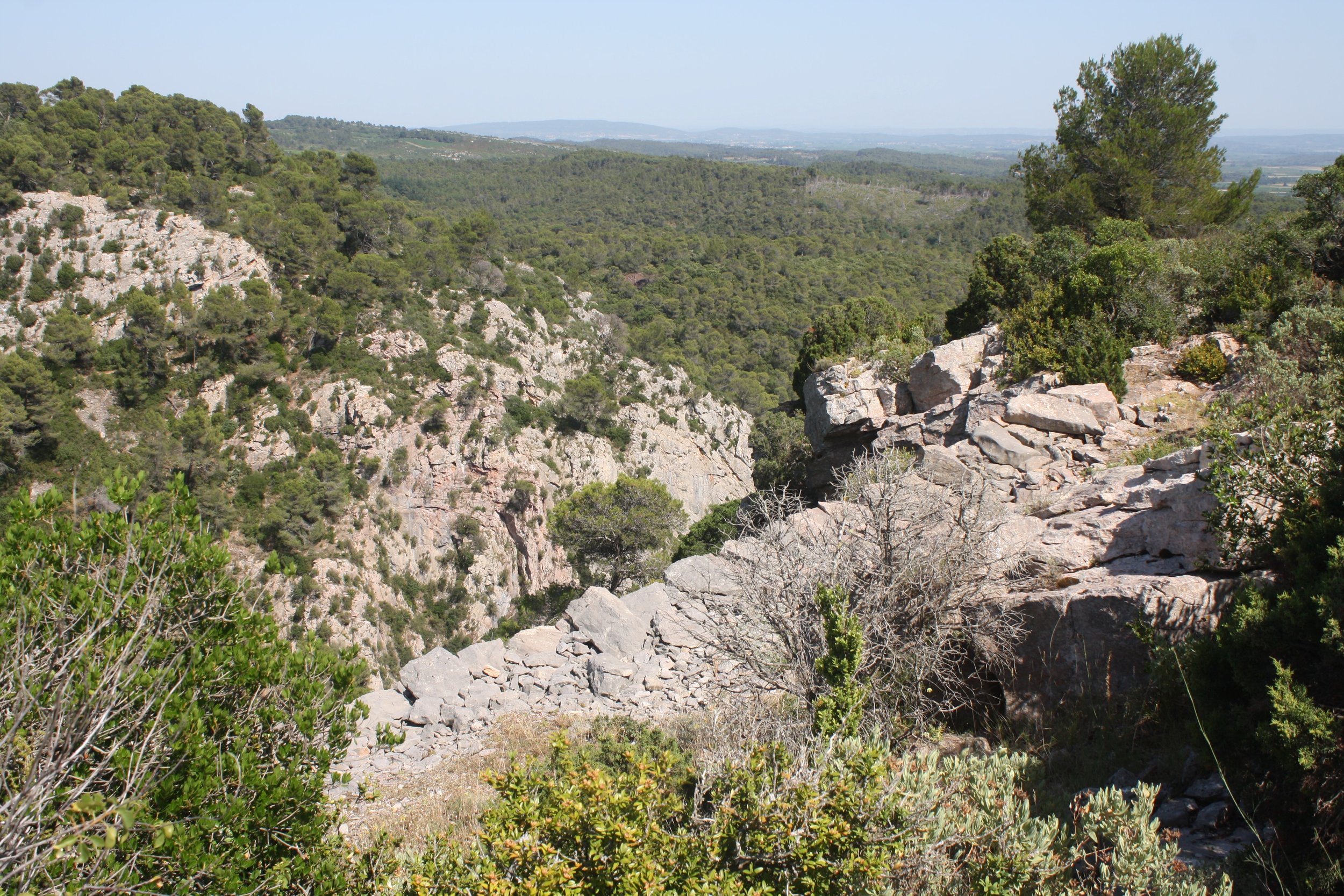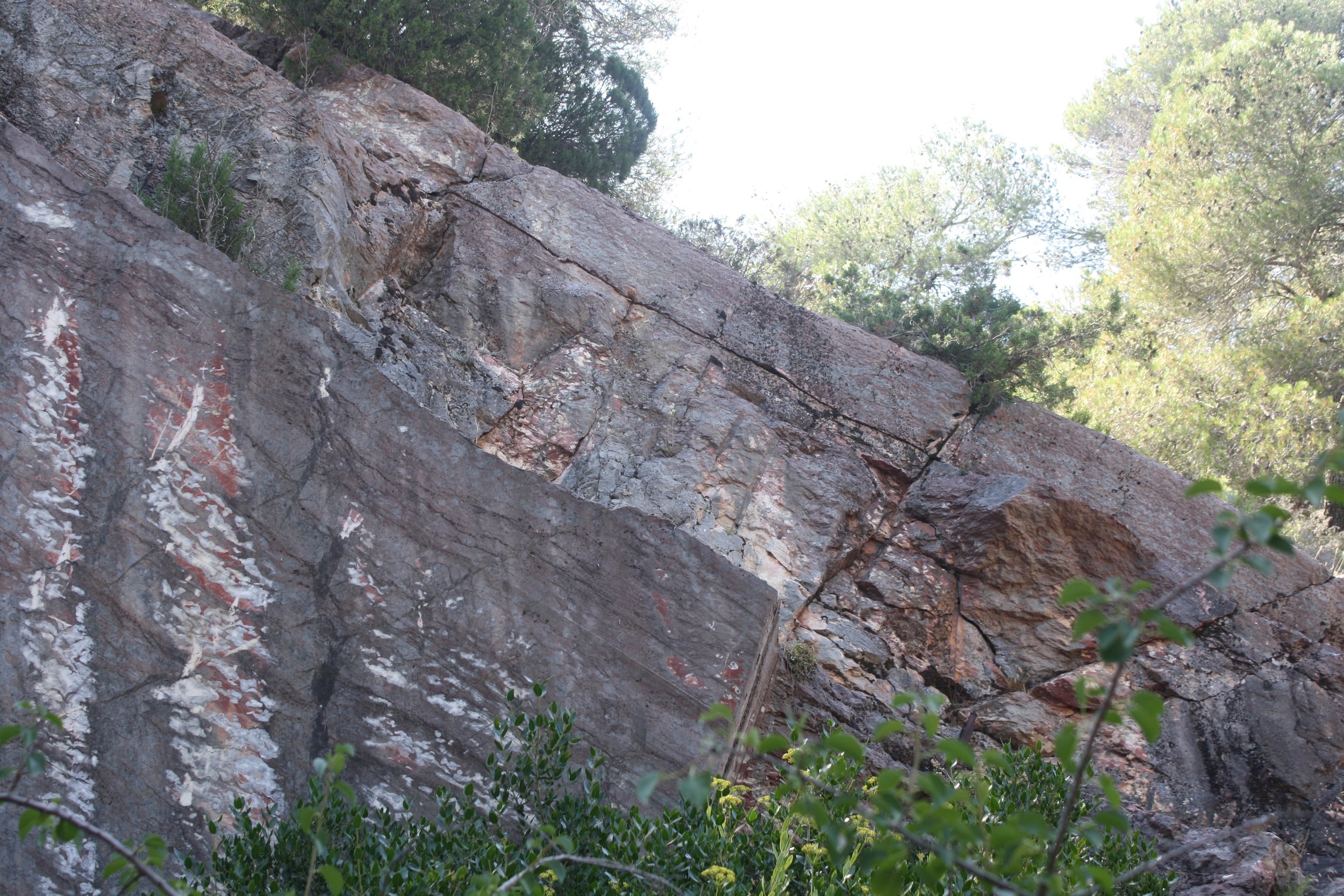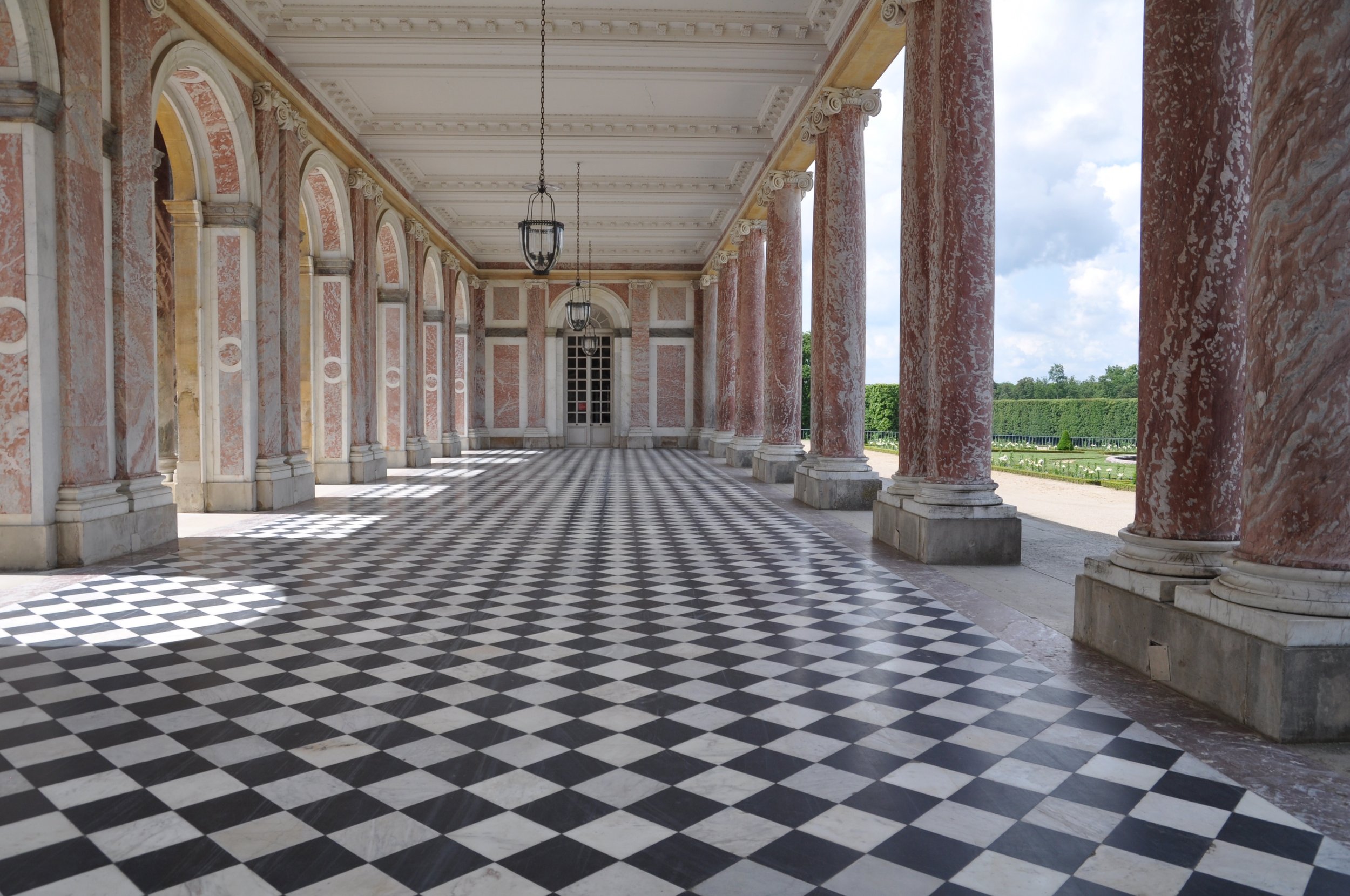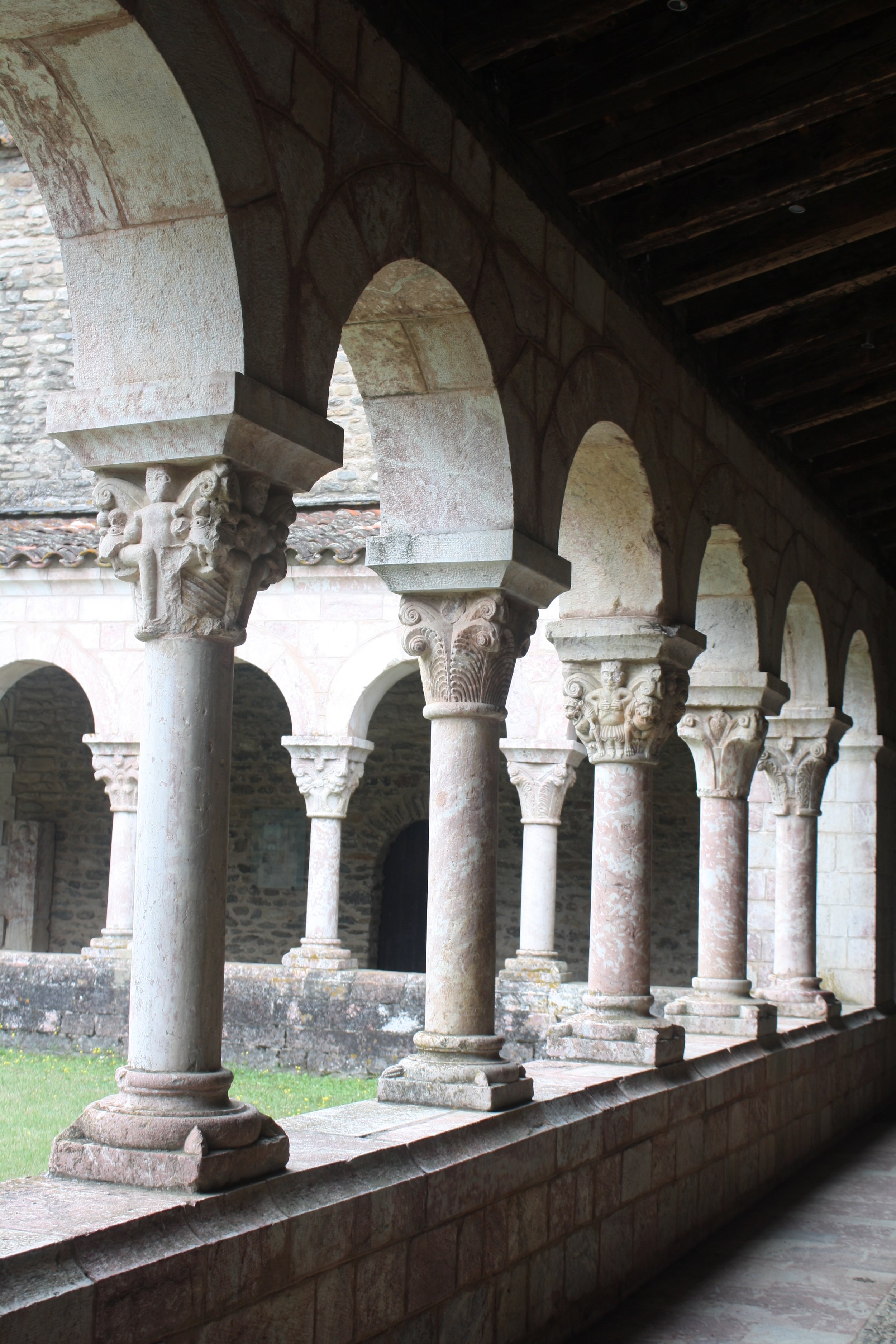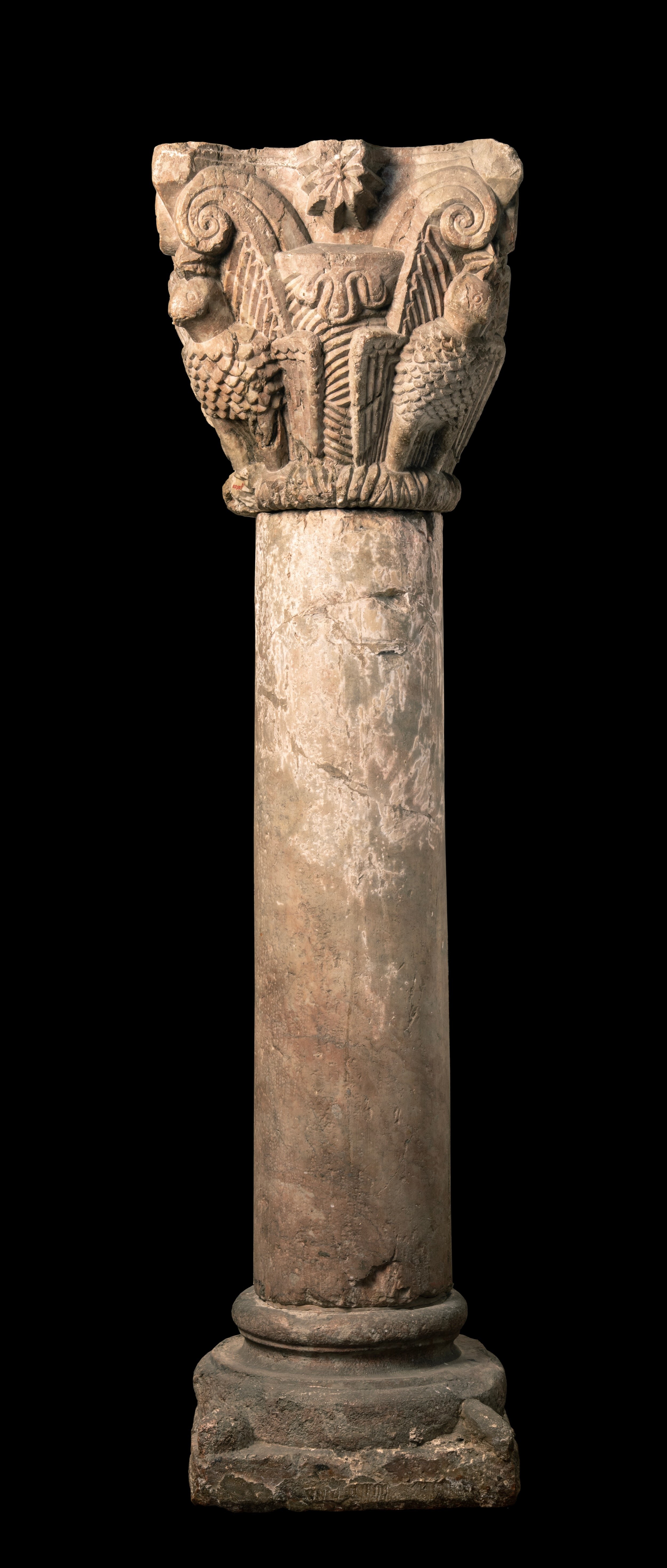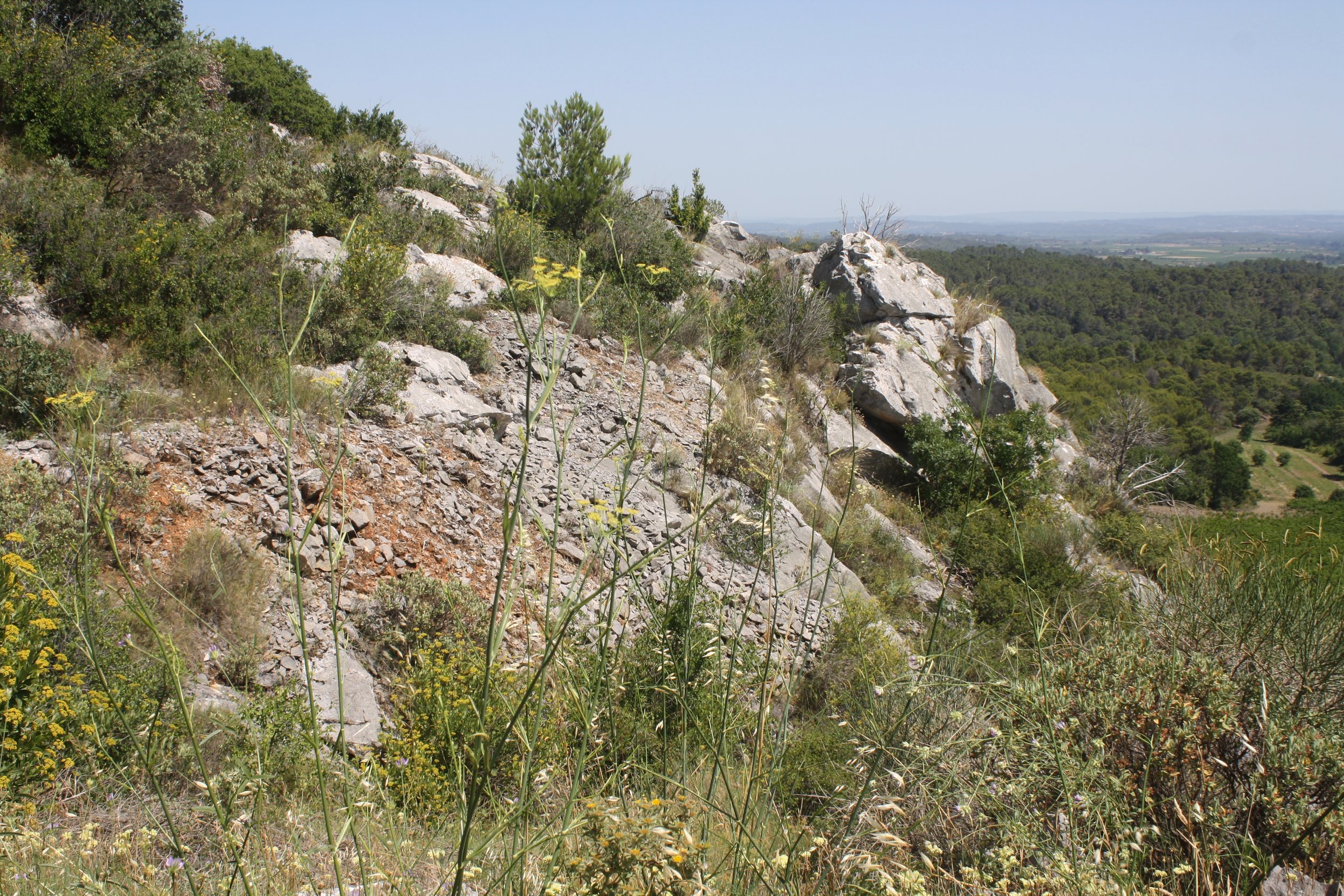Glencairn Museum News | Number 8, 2023
Left: Capital in the Glencairn Museum collection from Roussillon, France, ca. 1130 (09.SP.168). Right: Carrière du Roy (Quarry of the King), Caunes-Minervois, France. Several medieval sculptures at Glencairn were made from the distinctive pink stone in local quarries such as this one.
A French Field Trip
It was one of the hottest days I had experienced for a long time. Barely shielded from the punishing sun by my wide-brimmed hat, I took small sips from my water bottle, conserving the precious liquid, since there was no more to be found on the way. I followed the group along the narrow path up through the hills, resigned to the astonishingly loud screech of insects in my ears, since there was no ignoring it. We had passed plenty of telltale signs as to where we were—deep trenches cut into caches of gray living rock, rusting equipment, cables above our heads crisscrossing a clearing (Figure 1)—but now we were ascending a wooded slope.
Figure 1: The Quarry of the King, Caunes-Minervois, France. (Photo by Julia Perratore.)
Eventually, we reached a wide, flat ledge with a gravel road, which we followed for a few minutes more through the trees. Suddenly, a view opened up onto a deep gorge, its rocky slopes overgrown with scrub (Figure 2). Our guide led us along the ledge, which ran parallel with the gorge’s deep channel. And then, finally, we were there. Amid the wild irregularities of the natural landscape, we saw towering, sheer walls of stone cut smooth and straight, mottled red and gray flames patterning the surfaces like old-fashioned wallpaper (Figures 3–5).
Figure 2: The Quarry of the King, Caunes-Minervois, France. (Photo by Julia Perratore.)
Figure 3: The Quarry of the King, Caunes-Minervois, France. (Photo by Julia Perratore.)
Figure 4: The Quarry of the King, Caunes-Minervois, France. (Photo by Julia Perratore.)
Figure 5: The Quarry of the King, Caunes-Minervois, France. (Photo by Julia Perratore.)
Figure 6: The Quarry of the King, Caunes-Minervois, France. (Photo by Julia Perratore.)
I was at the Carrière du Roy—the Quarry of the King—outside the town of Caunes-Minervois in the far south of France, just north of the Pyrenees (Figure 6). The quarry took its name from its seventeenth-century exploitation for Louis XIV’s constructions in the palace complex of Versailles. In particular, the stone’s distinctive pink-to-red tones define Versailles’ monumental Grand Trianon (Figure 7), designed by the architect Jules Hardoin-Mansart and completed in 1687. I had visited Versailles, just outside of Paris, over twenty years ago and had no awareness of the connection to the south; it was fascinating to finally learn the great distance much of its stone had traveled.
Figure 7: The Grand Trianon, Versailles, 1687, designed by Jules Hardoin-Mansart. (Photo by Azurfrog - Own work, CC BY-SA 3.0, in Wikimedia
Commons.)
The primary reason for visiting the quarry, however, which I did as one of a group of fellow medievalists, was actually to try to travel much further back in time than the seventeenth century. The Quarry of the King is a more recent site of exploitation of the Languedoc region’s several deposits of speckled pink marble, which builders and sculptors have sought since antiquity. Because the many medieval quarries of this stone are no longer easily accessible, this more recent work site provided a useful point of comparison in understanding the landscape (Figure 8) and circumstances under which the stone was extracted, despite the presence of its modern quarrying equipment.
Figure 8: The Quarry of the King, Caunes-Minervois, France. (Photo by Julia Perratore.)
The quarry visit accompanied a conference I had attended during the first week of July, deep in the south of France at the monastery of Saint-Michel-de-Cuxa (Figure 9). Founded in the late ninth century, Saint-Michel still functions as a monastery (though currently with only one brother in residence). Its pink marble cloister (Figures 10–11)—created in the 1130s, dismantled after the French Revolution, and partially reconstructed in the 1950s—served as the central inspiration for the quarry visit. I have a particular interest in learning as much about the monastery and its stone as I can because the other half of the cloister of Saint-Michel-de-Cuxa is installed at The Met Cloisters in New York City (Figure 12), where I work as an assistant curator. Glencairn’s collection, however, is never far from my mind, and in this case, I was thinking of the smaller group of sculptures at Bryn Athyn that come from Cuxa and the surrounding region.
Figure 9: The Monastery of Saint-Michel-de-Cuxa. (Photo by Julia Perratore.)
Figure 10: Cloister, The Monastery of Saint-Michel-de-Cuxa, created ca. 1130, reconstructed 1950s. (Photo by Julia Perratore.)
Figure 11: Cloister capital, The Monastery of Saint-Michel-de-Cuxa, ca. 1130. (Photo by Julia Perratore.)
Figure 12: Elements from the Monastery of Saint-Michel-de-Cuxa, The Met Cloisters, New York, sculptures ca. 1130, installed within modern structure, 1930s.
A Collection of Capitals
Though the four marble capitals from Languedoc in Glencairn’s collection appear to come from different monuments, in appearance they still form a fairly homogenous group. All are carved from the distinctive local pink marble, and all are carved on all four sides, suggesting that they were made for cloister display. (A cloister is a covered walkway connecting the different buildings in a monastic complex, typically delineated by arcades with columns topped by decorated capitals.) Characteristic of the region, the decoration favors non-human creatures and plant forms, and the focal points of carving are situated on the capitals’ corners, catching viewers’ eyes easily as they walk past.
One example from Glencairn (Figures 13–14), said to come from Cuxa, depicts birds—possibly eagles, given the animal’s popularity in early twelfth-century art. The carving’s lively combination of jagged surface textures—layering the birds’ spiky feathers against accordion-pleat palm leaves—is typical of other capitals from Cuxa displayed at The Cloisters in New York. Another capital from Cuxa, acquired by Raymond Pitcairn but now in the collection of the Philadelphia Museum of Art, shows at each of two corners snarling beasts with two separate bodies sharing a single head.
Figure 13: Capital, said to come from the Monastery of Saint-Michel-de-Cuxa, France, ca. 1130, Glencairn Museum, 03.SP.129.
Two other examples relate closely to the Cuxa examples, but their different sizes suggest they came from a different local monument. One smaller example shows a group of grimacing lions with charmingly petite wings on their shoulders arranged in procession around the capital (Figure 15). (A personal favorite, I can understand why Mr. Pitcairn had a modern copy of this capital made for the porte-cochère of his home.) Another capital differs from the Cuxa examples above because the focal point of carving on each face of the capital is centered instead of on the corner (Figure 16). It pairs winged lions that effortlessly stand on their hind legs, their front paws delicately touching as they turn their heads away. The head of a bearded man peeks out above two animals at the top of the capital, perhaps reflecting the male monastic audience for which it was likely made.
Figure 14: Capital, said to come from the Monastery of Saint-Michel-de-Cuxa, France, ca. 1130, Glencairn Museum, 03.SP.129, 03.SP.130, 03.SP.131.
Figure 15: Capital, France (Roussillon), ca. 1130, Glencairn Museum, 09.SP.168
Figure 16: Capital, France (Roussillon), ca. 1130, Glencairn Museum, 09.SP.170.
Figure 17: Capital, Monastery of Saint-Pons-de-Thomières, France, second quarter of the twelfth century, Glencairn Museum, 09.SP.165.
Also worth mentioning is a fourth capital in Glencairn’s collection, carved from gray marble, which comes from the monastery of Saint-Pons-de-Thomières, located to the north of Cuxa (Figure 17). Its corner-concentrated carving, repeated four times, depicts another favorite subject of the period that is also seen in Cuxa and its environs: a hybrid beast. This one consists of a huge, glaring simian head surmounting a single pair of powerful feline legs. Caught in between two of the creatures is a youthful male figure holding a torch—surprisingly calm in this monstrous company. Today, it is difficult to know the significance of such imagery. Some of it seems to moralize, showing threatening beasts of the kind that sinners might encounter in the afterlife. Yet other images principally seem intent on drawing the viewer’s attention through their visual complexity, achieved through improbable forms, often repeated.
Overall, the similar materials, compositions, choices of subject, and also style—forms are simplified, the proportions tend to be squat, and sharply ridged surface textures recur—indicate that the sculptors at work in this far southern French region formed a closely connected network of associates who shared ideas and models freely. Since sculptors in this region did not sign their work in the conventional way, it is difficult to know how many there were. Sculptors did collaborate in workshops, typically consisting of multiple carvers at various stages of their career organized under one or more master carvers. Whether we see in the many similar capitals from the region the products of a single large workshop, or a loose confederation of different, but related workshops, there was clearly a strong consensus among sculptors about how carved capitals should look, which likely was determined in consultation with the monks for whom they worked.
Thinking Pink
One thing that does seem certain, however, is that these artists had close ties to the local sources of their principal materials—the magnificent pink marble of the Languedoc. Popularly known today by nicknames such as “Violet de Villefranche” and “Rouge de Ria” after places in which it has been quarried, the pink marble deposits of southeastern France appear not to have been tapped significantly when this part of Europe was under Roman dominion. For the nearby city of Narbonne, a provincial capital of Roman rule, much stone was imported; notably, marble was brought from Carrara, Italy to construct its major temple complex. After the Roman empire’s collapse in the west, and as a direct result of this downturn in political and economic fortunes, people in this region no longer habitually constructed new stone buildings for centuries. When stone was needed during the early Middle Ages, the many disused buildings of Narbonne were “quarried” for materials. It was only during the first decades of the twelfth century, a time of economic, political, and cultural reinvigoration, that local people developed anew the desire, the means, and the know-how to source stone from natural deposits on any significant scale. Once the ability to exploit the local quarries was secured, there was something of a pink explosion in the region.
Obtaining the stone was no easy undertaking. The preferred method of transporting stone at that time was to float it in barges from the quarry down the nearest navigable body of water, but this was not an option for the marble quarry near the town of Villefranche-de-Conflent, for example, which lies close to Cuxa. There, marble was transported overland. Even when assisted by simple machines and draft animals, such work was backbreaking. When I climbed and descended the comparably steep and uneven terrain of the Quarry of the King further north (Figure 18), I gained new perspective on the difficulties and dangers of medieval efforts to obtain stone. I also reflected on scholars’ frequent suggestions that once rough blocks of stone had been separated from a natural deposit, sculptors worked them at the quarry, at least partially shaping the desired form of the finished product in order to reduce some of the bulk before transport. Though most of the stone quarried in the southeast remained local during the Middle Ages, a Herculean effort was occasionally made to bring the pink marble to Spain, whether across the Pyrenees to the monastery of Ripoll or farther afield (and likely by sea) to the city of Valencia on the Mediterranean coast.
Figure 18: The Quarry of the King, Caunes-Minervois, France. (Photo by Julia Perratore.)
Benedictine monks such as those resident in the community at Saint-Michel-de-Cuxa were not meant to be attached to earthly things. However, to suddenly see emerging from the earth a material whose tones ranged from a faint blush to a deep rose, shot through with delicate swirls of cream and grey and which could patinate into a glossy wine stain, must have pleased the local monks. It clearly seems to have delighted the twelfth-century abbots of the region, charged with building and rebuilding the various structures of the monastic complexes that they headed, since they chose it time and again for the most visually prominent portions of these constructions, such as church portals, cloister arcades, altar tables, and fountains. I can only agree that it was worth the effort.
Julia Perratore, PhD
Assistant Curator, Department of Medieval Art and The Cloisters
The Metropolitan Museum of Art
Sources
Hayward, Jane. Radiance and Reflection: Medieval Art from the Raymond Pitcairn Collection. New York: The Metropolitan Museum of Art, 1992.
Mallet, Geraldine. “De l’usage des marbres en Rousillon entre le XIe et XIVe siècle: La sculpture monumentale.” Patrimoines du sud 4 (2016), pp. 29–51.
Would you like to receive a notification about new issues of Glencairn Museum News in your email inbox (12 times per year)? If so, click here. A complete archive of past issues of Glencairn Museum News is available online here.



